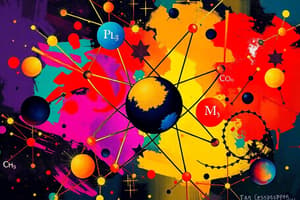Podcast
Questions and Answers
What is the weighted average formula used to calculate the atomic mass of an element?
What is the weighted average formula used to calculate the atomic mass of an element?
- Atomic Mass = Mass_1 / %_1 + Mass_2 / %_2
- Atomic Mass = (Mass_1 × %_1) + (Mass_2 × %_2) (correct)
- Atomic Mass = (Mass_1 + Mass_2 + Mass_3) / 3
- Atomic Mass = (Mass_1 + Mass_2) / 2
Given the isotopes of Ne, how do you calculate the average atomic mass?
Given the isotopes of Ne, how do you calculate the average atomic mass?
- Average Atomic Mass = (19.992 + 20.994 + 21.991) / 3
- Average Atomic Mass = 19.992 / 90.51 + 20.994 / 0.27 + 21.991 / 9.22
- Average Atomic Mass = 19.992 + 20.994 + 21.991
- Average Atomic Mass = (19.992 × 0.9051) + (20.994 × 0.0027) + (21.991 × 0.0922) (correct)
Which of the following isotopes of copper has a higher atomic mass, and what are their respective values?
Which of the following isotopes of copper has a higher atomic mass, and what are their respective values?
- Cu-63 with 64.93 amu and Cu-65 with 62.94 amu
- Cu-63 with 62.50 amu and Cu-65 with 64.93 amu
- Cu-63 with 63.55 amu and Cu-65 with 65.00 amu
- Cu-63 with 62.94 amu and Cu-65 with 64.93 amu (correct)
What is the average atomic mass of naturally occurring carbon based on the isotopes 12C and 13C?
What is the average atomic mass of naturally occurring carbon based on the isotopes 12C and 13C?
Which of the following statements is true regarding Strontium's isotopes?
Which of the following statements is true regarding Strontium's isotopes?
What is the main conclusion of the gold foil experiment conducted by Rutherford?
What is the main conclusion of the gold foil experiment conducted by Rutherford?
How do isotopes of an element differ from each other?
How do isotopes of an element differ from each other?
Which statement correctly defines the atomic number?
Which statement correctly defines the atomic number?
What was a significant finding about radiation by Marie Curie?
What was a significant finding about radiation by Marie Curie?
What charge does a magnesium ion (Mg+2) carry compared to a neutral magnesium atom?
What charge does a magnesium ion (Mg+2) carry compared to a neutral magnesium atom?
Which of the following particles has a mass of approximately 1 amu and no charge?
Which of the following particles has a mass of approximately 1 amu and no charge?
What does the mass number of an isotope represent?
What does the mass number of an isotope represent?
What did Ernest Rutherford conclude from his experiments involving the Plum Pudding Model?
What did Ernest Rutherford conclude from his experiments involving the Plum Pudding Model?
Flashcards are hidden until you start studying
Study Notes
Chemistry Basics and Concepts
- A 25.00g sample of HCN contains 12.96g of nitrogen (N) and 11.11g of carbon (C).
- Mass of carbon in a 45.00g sample of HCN can be determined based on the ratio of carbon in the original sample.
Atomic Structure and Models
- Rutherford Model: Concluded atoms consist mainly of empty space, with a dense, positively charged nucleus containing protons.
- Major findings from the gold foil experiment include:
- Atoms are mostly empty space.
- The nucleus contains most of the atomic mass.
- Protons are housed in the nucleus.
Isotopes and Atomic Notation
- Carbon isotopes include Carbon-12 and Carbon-14, with identical atomic numbers but different mass numbers, implying different neutron counts.
- Isotopic notation includes:
- Atomic number (Z): Number of protons defining the element.
- Mass number: Sum of protons and neutrons.
- Total ionic charge reflects the sum of the charges of protons and electrons.
Atomic Mass Calculations
- Atomic mass of an element is a weighted average of all its isotopes, resulting in fractional values.
- For carbon, the average atomic mass is calculated using naturally occurring isotopes, where 12C is 98.89% while 13C is 1.11%.
Example Calculations
- For Neon, determine atomic mass by calculating the weighted average based on its isotopes:
- 20Ne: 19.992 amu at 90.51%
- 21Ne: 20.994 amu at 0.27%
- 22Ne: 21.991 amu at 9.22%
More Isotope Examples
- Copper's atomic mass is 63.55 amu, with copper isotopes Cu-63 (62.94 amu) and Cu-65 (64.93 amu). Calculation of percent abundance required.
- Strontium has four isotopes with varying abundances; identifying which predominate based on given data is essential for understanding stability and composition.
Notable Scientists
- Marie Curie: First person to win two Nobel Prizes in different scientific fields (Chemistry and Physics). Concluded that radiation comes from within the atom.
- Ernest Rutherford: A student of J.J. Thomson, confirmed the Plum Pudding Model and is recognized for the gold foil experiment which contrasted with earlier atomic models.
Atomic Properties Chart
Key properties include:
- Proton: Mass = 1.007 amu, Charge = +1, Location = nucleus.
- Neutron: Mass = 1.009 amu, Charge = 0, Location = nucleus.
- Electron: Mass = 0.00055 amu, Charge = -1, Location = electron cloud surrounding nucleus.
Studying That Suits You
Use AI to generate personalized quizzes and flashcards to suit your learning preferences.



